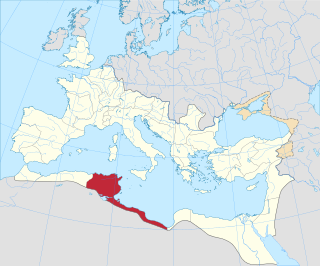Serra is a titular see of the Roman Catholic Church.

Turrisblanda, was a Roman and Byzantine era colonia (town) in the Roman Empire province of Byzacena in what is today modern Tunisia. Its exact location remains unknown. It was also a capital of an historic diocese of the Roman Empire. The bishopric remains today as a titular see of the Roman Catholic Church. The current bishop is Jan Szkodoń, Auxiliary Bishop of Cracow.
Villamagna in Proconsulari was a town in the Roman province of Africa Proconsulare. It is identified with the modern village of Henchir Mettich located around 50 km from Carthage in Tunisia.

Tibiuca was a Roman era civitas of the Roman province of Africa Proconsularis.

The Diocese of Sinnuara is a sede soppressa and titular see of the Roman Catholic Church. The bishopric is suffragan to the Archdiocese of Carthage.

Utimmira, was an ancient Roman town of the Roman province of Africa Proconsularis near Carthage in today's Tunisia, the exact location of which has been lost to history.
Paria in Proconsulari is an Ancient town and former bishopric in Roman Africa and now a Latin titular see of the Roman Catholic Church.

The Diocese of Gisipa is a home suppressed and titular see of the Roman Catholic Church, suffragan of the Archdiocese of Carthage.

Lapda, was a civitas (town) of the Roman province of Africa Proconsularis. Its exact location is now lost to history, though probably somewhere in central modern Tunisia. Also known as Labdia.

Melzi was a civitas (town) of the Roman Empire during late antiquity. It was also known as Meditanus.

Mattiana was a Roman-Berber civitas in the province of Africa Proconsularis. The locale existed during late antiquity, and was situated in northern Tunisia.

Culusi was a Roman town of the Roman province of Africa Proconsolare, located near Carthage. It is also known as Culcitana or Culsitana. The city is tentatively identified with ruins in the suburbs of Tunisia.

Migirpa was an ancient Roman-Berber civitas in the province of Africa Proconsularis. It flourished from 30 BCE to 640 CE. The town is identified as stone ruins near Carthage, Tunisia.

Maximiana in Byzacena is a titular bishopric of the Roman Catholic Church. It goes back to a former bishopric in the Roman province of Byzacena or Africa proconsularis in the Sahel region of Tunisia.

Autenti was a Roman–Berber civitas and bishopric in Africa Proconsularis. It was a diocese of the Roman Catholic Church.

Crepedula was an ancient Roman–Berber civitas in the province of Byzacena in Africa Proconsularis. It was located in modern Tunisia. The town was also the seat of a Catholic diocese.

Cufruta was an ancient Roman-Berber civitas in the province of Byzacena. It was also the seat of a Roman Catholic diocese.

Muzuca was a Roman Town of the Roman province of Byzacena during late antiquity. The town has tentatively been identified with the ruins at Henchir-Besra in modern Tunisia. Very little is known of the city, though in situ epigraphical evidence gives us the name and that in late antiquity it achieved the status of Municipium.
Satafi, was a Roman town in the Roman province of Mauretania Caesariensis, North Africa. It lasted through the Vandal Kingdom and Roman Empire, until at least the Muslim conquest of the Maghreb, in late antiquity. An exact location of the town is not known but, it was probably in Algeria.
The diocese of Garba is a suppressed and titular see of the Roman Catholic Church.


